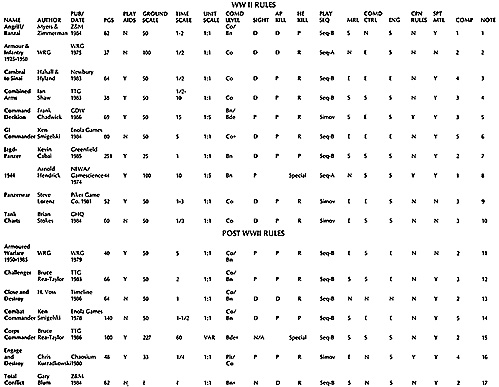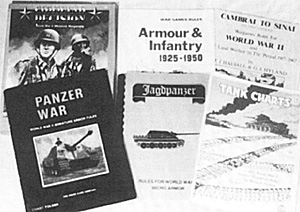
EXPLANATION OF CHART HEADINGS
Scales: yards/minutes/vehicles per inch/turn/miniature respectively.
Command Level: optimal command level for one player.
Sight:
- D - Deterministic: If one is within a unit's sighting range and in LOS, one is seen.
P - Probablistic: If one is at a given range from a unit and in LOS, there is a finite chance that one is seen.
N - None: If one is in a unit's LOS, one is seen.
AP Kill:
- D - Deterministic: Constant armor penetration is used for a given projectile to determine whether the target's armor is defeated.
P - Probablistic: The penetration of a projectile is variable when determining whether the target's armor is defeated, reflecting varying armor and projectile quality and differing impact points (eg: projectile struck a bolthead or a tool attached to the target's hull, etc.).
HE Kill:
- R - Ranged: The likelihood of unit A hitting and damaging unit B with non-antitank fire is modified by the range to unit B.
P - Unranged: The likelihood of unit A hitting and damaging unit B with non-antitank fire is not modified by range.
Play Sequence:
- SEQ-A: Player A moves and fires all units. Player B then does the same.
SEQ-B: Players perform actions sequentially, but both may perform actions in the same phase, eg: Side A move, Side B move, both shoot, Side B move, Side A move.
SIMOV: Players perform all actions simultaneously.
Command Control: N, S, E Not addressed, Simple, Extensive.
Morale (MRL): N, S, E Not addressed, Simple, Extensive.
Engineering: N, S, E Not addressed, Simple, Extensive.
Supporting Materials: what background, equipment data, painting guides, organizational information, etc., are included with the rules?
Complexity: 1 (Simple) to 5 (Complex)
 1. BANZAI is essentially the same rule set as ANGRIFF, but focuses, in terrain types and equipment, on the Pacific Theater. Some organization tables are included; others are published under separate covers. Bibliography, background information and miniatures sources are listed. Slope is ignored in determining armor value, which causes some problems. An armor value is assigned to the hull and turret of each vehicle facing. Neither air-power nor Command Control rules are included, and morale is extremely basic. The rules are simple and fast, and are a good introductory set.
1. BANZAI is essentially the same rule set as ANGRIFF, but focuses, in terrain types and equipment, on the Pacific Theater. Some organization tables are included; others are published under separate covers. Bibliography, background information and miniatures sources are listed. Slope is ignored in determining armor value, which causes some problems. An armor value is assigned to the hull and turret of each vehicle facing. Neither air-power nor Command Control rules are included, and morale is extremely basic. The rules are simple and fast, and are a good introductory set.
2. Rules include a point system for building forces. The alternative ground scale given is 25 yards per inch. Vehicle data included with the rules are minimal. Command Control is simple in concept, but requires written orders to implement. Morale is not addressed at all. A single armor factor is used for each facing of a vehicle, and is generalized into one of six simplified thickness categories, which, to me, blurred the distinctions between the various armored vehicle types.
3. Rules are very detailed. The engineering rules are the most detailed of the lot. The infantry rules, though a bit more cumbersome to use than the norm due to their detail, work well. A single armor factor, derived from its sloped thickness, is used for each face of the vehicle. Supporting materials include a bibliography, and army lists published under separate cover. The alternate ground scale given is 25 yards per inch.
4. Rules include particularly good spotting charts. Very detailed direct fire-to-hit tables are included. The damage resolution mechanism is somewhat abstracted. Armor slope is rounded to either 0 degrees or 45 degrees for determination of effective armor thickness, which reduces, but does not eliminate lack-of-slope distortions. Armor thicknesses are given for turret and hull armor for each face of the vehicle. Good engineering rules are included. The alternate ground scale given is 25 yards per inch. A point system is included for building forces. Extensive army lists are published under separate cover.
5. The game can be played real-time! The game design specifically addresses grandtactical battles. Command Control is central to game. Extensive organization tables are included as well as bibliography and a brief guide to miniature building. Miniatures represent platoons/batteries, not individual vehicles. Alternate ground scale given is 127 yards per inch. See review this issue.
6. Extensive organization and vehicle data charts are included. The rules cover everything. The Command Control rules force the player to plan very carefully - units cannot simply be thrown around the battlefield as needed, as in many other rule sets - having a unit sit "awaiting orders" can and does happen in these rules, and can be very frustrating if the controlling player doesn't plan for it. The AFV kill procedure is somewhat abstracted, but does result in dead tanks. An armor factor is assigned to the hull and turret of each face of an armored vehicle, and is derived f rom that side's sloped armor value. Further (German) organizations are published under separate cover.
7. A very simple, fast set of rules that covers just about everything. The equipment tables are the most extensive surveyed, covering numerous vehicles I'd never heard of. The organization tables, in numerous instances, referenced specific organizations, a nice touch. Hull and turret armor factors derived from sloped armor values are given for each face of each vehicle referenced. Command control is very abstract; rather than planning it in, by writing orders for units, etc., it is planned for; players are limited in how much time they have to move units; additionally, each unit's Command Control is determined by die roll each turn to see if the units do what they're told.
8. Rules are very simple and fast. They are operational level, with miniatures representing platoons and batteries. Units all have single armorvalues based on their overall armoredness. Direct fire hit determination and damage resolution are resolved with a single range-dependent die roll. Naval rules! Command Control rules are very rudimentary. Some unit organizations are included, as is a point system. The set to which they can be most directly compared is "Command Decision" (above). The twelve year difference in publication date is apparent.
9. Superb unit morale rules are central to this game. Close-in movement is sequential, based on initiative. Hill and turret armor factors per (7) above are used. Hit location and damage resolution are quite detailed, as is the Command Control system. A point system is included.
10. The spotting system, though deterministic, is quite detailed. Close-in movement is sequential, based on initiative. Engineering is limited to minefields. Ground scales given range from 8 yards per inch to 100 yards per inch. Hit location and damage resolution are very detailed. Hull and turret armor factors per (7) above are used.
More 20th C. Land Battle Rules A Survey
Back to Table of Contents -- Courier Vol. VII #5
To Courier List of Issues
To MagWeb Master Magazine List
© Copyright 1987 by The Courier Publishing Company.
This article appears in MagWeb (Magazine Web) on the Internet World Wide Web.
Other military history articles and gaming articles are available at http://www.magweb.com